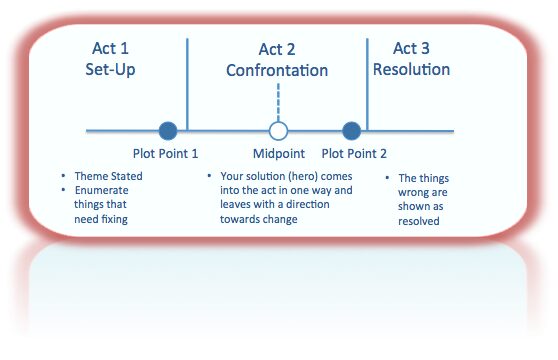In a story, you provide the context to customers and can drive points home harder. Through stories, facts and raw data gain meaning. Stories are how we best learn and visualize information. They simplify and clarify even the most complex information. They can hook an audience with emotion. Additionally, stories help people remember what they’ve heard.
Sales reps have been discouraged to use storytelling in a business presentation because the common thought is that it should be reserved for keynote addresses or rousing motivational speeches. Use Cases which are “stories from the field” are particularly effective.
While there are many types of stories, a vision story uses vivid details. When telling this type of story you want to be concrete as opposed to abstract. Use four qualities of effective stories: conflict, characters, vivid details and a clear theme.
A great sales presentation is similar to a screenplay. You have your use set-up, confrontation and resolution in proportion as popularized by late screenwriter Syd Field:
How to tell a story through a slide deck:
Beginning: Paint a picture of the realities of the audience’s current world (e.g. “What it is”). At the tail end of the “Beginning”, create an imbalance by stating what could be juxtaposed to what is (Plot Point 1)
Middle: Present contrasting content, alternating between “what it is” and “what it could be”. At the tail end here, articulate the finish line that the audience is meant to cross (Plot Point 2).
End: End the presentation on a higher plane than it began, with everyone understanding the reward in the future. Reward example: present your sales pitch smarter, easier, and more successfully.
Cross the Threshold: The audience leaves the presentation committed to taking action, knowing it won’t be easy but will be worth the reward.
So why do airless, soul-less slide presentations fall flat? Statistics, charts, and bulleted facts encourage audiences to process information critically and think of reasons to agree and reasons to disagree. On the other hand, stories are processed differently. Stories relax the audience and encourage them to use their imagination and emotions. This results in what the Journal of American Folklore has cited to result in a qualitatively different state of consciousness- putting the audience into a “story listening trance”.
3 Tips for Effective Storytelling:
- Keep your stories short—two to three minutes at most. Leave out any unnecessary detail. Use your story to quickly clarify or support a point you’re making, then move on.
- A good story puts information in perspective. It doesn’t replace information.
- A good story paints a picture. It helps your listeners “see” what you’re saying.
While the principles of storytelling remain the same, its convergence with a digital platform has given us different mediums in which we can present and share that message. Here are a few digital visual storytelling tools for sharing your business brand with your global audience:
CustomShow: This storytelling tool allows you to visualize brand identity, graphics, and animation to turn commonplace bullet points into powerful messaging. This enterprise software solution has been developed to allow real-time editing, cross-team functionality, and robust analytics to measure and improve the sales process.
Projeqt: Projeqt is a dynamic presentation platform that allows you to pull lie tweets from blog feeds, insert interactive maps, add audio notes, or stream videos you’ve found on the web. Created by TBWAWorldwide and Pilot. is, an internal product development unit that creates products living at the intersection of marketing and engineering.
Story Wheel App: This app lets you record a story around your Instagram pictures and share it on the web as a slideshow.
StoryMarkLife: This app has you to take a picture with your phone camera, record your voice or add other sounds and save for yourself or to share with colleagues and friends.
FotoBabble: A photo and audio powered social media content aggregator that turns static photos into stories Helps organizations attract and engage audiences across web, mobile, and social networks.
QWiPS: A useful social voice utility that lets you add your spoken voice to the social conversation.
Meograph: This tool enables businesses to create multimedia stories and engage their customers in the creation process.
Storify: Helps you find the best first-hand reports for your next news story by using social media to break news. Storify connects to social media sites to enable an all-in-one search experience.
Interested in improving your sales process? Schedule a demo to learn more about CustomShow here.
Every good presentation is a good presentation builder that fit the intricacies and identity of your organization. At CustomShow, we believe our presentation software can do just that.

